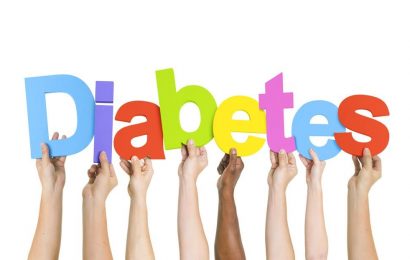“I can tell you one thing — growing old ain’t for wimps!”
—gray-haired gentleman at Sterling Center YMCA in Beverly, Massachusetts
It used to be said that having diabetes aged people an additional 20 years. Today, thanks to better tools for managing diabetes and preventing and treating its complications, people with diabetes have the opportunity to live longer than ever before. However, managing diabetes in the golden years presents a variety of challenges, ranging from increased insulin resistance to being on multiple drugs. Here is what you should know about the effects of diabetes on aging and vice versa, and what you can do to stay healthy and full of vitality well into old age.
What happens during aging
As you age, you may be most aware of your new gray hairs and wrinkles, but aging causes changes throughout the entire body. A person’s basal metabolic rate — the amount of energy the body expends at rest — declines with age. By some estimates, a person’s basal metabolism drops by 2% per decade starting at age 20. Some researchers believe that this decline is due almost solely to the loss of muscle mass that comes with age.
The body’s ability to process oxygen — its aerobic capacity — also declines with age. By some estimates, a person’s aerobic capacity by age 65 is typically only 60% to 70% of what it was when he was younger (although the decline appears to be less in older people who exercise regularly). This decline may be due to several factors, including poor lung function, heart function, and blood circulation.
With advancing years, the body gradually becomes less adept at taking up and using glucose from the bloodstream — a condition known as glucose intolerance, which sets the stage for Type 2 diabetes. One contributing factor to glucose intolerance is a condition known as insulin resistance, in which people’s body tissues become less and less sensitive to insulin. This may be due to having too much body fat, which interferes with the muscles’ ability to use insulin.
The mineral content of bones also declines with age, leaving older people with weaker, more brittle bones. This may be related to poor nutrition, deficient calcium absorption, inactivity, and, in women, hormonal changes after menopause. Brittle bones set the stage for osteoporosis (a condition of having abnormally porous bones) and fractures, which can be devastating for older people.
The cartilage around joints tends to break down and wear away over time, causing pain, swelling, and loss of motion of the joints. In fact, about half of people age 65 or older have x-ray evidence of osteoarthritis in at least one joint.
In the United States, where people tend to eat too much of the wrong foods and exercise too little, blood pressure tends to rise with age. Poor diet, inactivity, weight gain, and a slower metabolic rate all set the stage for circulatory problems and cardiovascular disease.
Meanwhile, people’s visual acuity diminishes. They have difficulty seeing things up close and adjusting to changes in the level of light. People’s hearing may become affected as well, as they lose the ability to hear sounds in the upper frequencies or to hear distinct sounds when there is a lot of background noise. Sense of taste may be affected as well. Certain cognitive abilities, such as spatial ability, reasoning, complex problem solving, and working memory, all tend to decline somewhat with age.
How diabetes contributes to aging
Diabetes and its complications can contribute to or mimic the aging process in a number of ways. There is some evidence that high blood glucose itself can contribute to aging. Glucose in the blood binds to proteins throughout the body through a process called nonenzymatic glycation. As glucose and protein interact chemically, they produce a number of metabolic by-products, including advanced glycosylation endproducts (AGEs). Unlike other metabolic by-products, AGEs do not break down; instead, they accumulate throughout the body.
AGEs are chemically very reactive, and they combine with other molecules to form bonds called cross-links. These cross-links change the nature of the body’s cells, tissues, and blood vessels, making them stiff and dysfunctional. While these changes occur in all people as they age, the process is greatly accelerated in people with diabetes. AGEs are thought to contribute to diabetes complications, including cardiovascular disease, diabetic eye disease, diabetic nerve disease, and diabetic kidney disease.
Diabetes complications can also speed up the aging process. Eye diseases related to diabetes, including retinopathy, macular edema, and cataracts, can worsen already fading eyesight. Diabetic nerve disease can complicate the arthritis that comes with age, sometimes allowing greater joint erosion in the foot (a condition known as Charcot joint). Diabetic kidney disease can speed the decline in kidney function often seen with age. Cardiovascular disease can age virtually any tissue in the body by diminishing its blood supply.
How aging may affect diabetes control
Aging can make diabetes more difficult to control. One reason for this is that insulin resistance increases and glucose tolerance decreases with age, but there are other, indirect reasons as well.
As people’s attention declines with age, they may be less able to focus on the tasks associated with diabetes management, such as carbohydrate counting, meal planning, blood glucose monitoring, and determining correct insulin doses. Furthermore, loss of visual acuity may make it more difficult to accurately monitor blood glucose levels or draw up insulin doses.
One major problem in elderly individuals with diabetes is hypoglycemia, or low blood glucose. Elderly people with diabetes are especially prone to hypoglycemia for a number of reasons, including the following:
- Many elderly people take multiple drugs, some of which may directly cause hypoglycemia, and some of which may interact with diabetes drugs to cause hypoglycemia.
- Elderly people may have impaired glucose counterregulation, a condition in which the body is less likely to release certain hormones that normally protect against low blood glucose levels by raising blood glucose levels when they fall dangerously low. People with impaired glucose counterregulation are also less likely to experience the usual symptoms that herald the onset of hypoglycemic episodes, such as sweating, trembling, dizziness, and headache, which prevents them from taking the necessary steps to address it. And even if they are aware of the hypoglycemia, the cognitive symptoms of severe hypoglycemia (such as confusion) may prevent them from responding appropriately.
- Elderly people may be at greater risk for an age-related decline in liver and kidney function, which may slow down the metabolism of certain oral diabetes drugs. This can leave the drugs in their bloodstream longer than normal, setting the stage for hypoglycemia.
- Elderly people may be more likely to have poor appetites and miss meals — especially if they have delayed stomach emptying from diabetic autonomic neuropathy — and this may predispose them to developing hypoglycemia.
Counteracting the effects of aging — and diabetes
While there is no such thing as a fountain of youth, there are a number of steps you can take to counteract some of the deleterious effects of aging — and diabetes — so that you can remain vital well into your older years. Here are some of those steps:
Pay attention to your numbers
One important measure for ensuring health in later years is controlling blood glucose levels, since high blood glucose tends to accelerate the effects of aging and increases the risk of developing diabetes complications. If you’re especially prone to hypoglycemia, it becomes even more important to regularly monitor your blood glucose levels.
Controlling blood pressure and blood lipid levels (cholesterol and triglycerides) can help prevent atherosclerosis, or “hardening of the arteries,” and the damage it wreaks throughout the body. Since obesity contributes to a number of afflictions, including diabetes, heart disease, stroke, and osteoarthritis, maintaining a desirable body weight can help keep you healthy throughout life.
Stay physically active
Many of the effects of aging, including a slower metabolism and diminished aerobic capacity, are not due directly to age as much as decreased muscle mass. Various forms of exercise, however, can help maintain muscle mass and ward off a host of afflictions. Aerobic exercise, such as running, bicycling, swimming, and walking, is known to help lower blood glucose levels in people with diabetes. Further, over time it increases stamina, aids in weight loss, and helps decrease the risk of cardiovascular disease.
Strength training has numerous benefits as well. Health experts have known for years that resistance or strength training can help reduce a person’s cardiovascular risk by lowering blood pressure, aiding in weight control, and improving cholesterol levels. But its benefits don’t end there: By building muscle mass, strength training may also stave off the decline in energy expenditure that led to Type 2 diabetes in the first place. It appears that both strength training and aerobic exercise may improve glucose metabolism and may help to significantly improve blood glucose control in people with established diabetes.
Also, bone density decreases with age, and one in four women in the United States eventually develops osteoporosis. Even more than aerobic exercise, strength training can increase bone density and help stave off osteoporosis.
Chronic progressive osteoarthritis is very common in older people, and rheumatologists often recommend strength training as one means of slowing the disease. Resistance training cannot reverse arthritis, but the stronger the muscles, tendons, and ligaments around a joint are, the less stress, friction, and pain there will be.
Strength training, like aerobic exercise, can give people a sense of well-being, and it may help alleviate the depression that sometimes accompanies aging and diabetes.
Strong arms and legs also make everyday activities easier, whether it’s carrying groceries, climbing stairs, or getting in and out of the bathtub. Strong ankles and thighs help prevent falls, which are the most common cause of injuries in senior citizens and are a common reason for being admitted to a nursing home.
It’s practically never too late to start strength training. A number of studies have shown that people in their 70s, 80s, and even 90s can dramatically increase their muscle mass and their strength through high-intensity strength training. Since strength training carries some risk of injury, especially when starting out, it’s a good idea to receive proper training with the equipment at a YMCA or other health club. As always, check with your doctor before embarking on any exercise program.
Other types of activity can also enhance flexibility and balance, two other aspects of physical fitness that tend to diminish with age. Practicing yoga or tai chi, for example, can improve flexibility, strengthen muscles around joints, and improve a person’s balance. The meditative aspects of these practices are also thought to relieve stress, improve mental focus, and possibly even help alleviate lethargy and depression. People can try out yoga or tai chi by taking classes at a local YMCA or health club, or by buying, borrowing, or viewing one of the many “how to” yoga and tai chi videos that are now available in stores, online, and at the library.
Eat right
How and what you eat can make a big difference in terms of how well you age. This means, first and foremost, following your diabetes meal plan, which is designed to help you maintain a healthy weight, improve your blood glucose control, and control your blood lipid levels. Research suggests that a diet rich in a variety of plant-based foods may help reduce the risk of heart disease and cancer. However, some older people do not get or cannot absorb all the nutrients they need from their diets. Speak with your health-care team about which dietary supplements you may need.
Get a good night’s sleep
Another key to maintaining your vitality throughout life is getting a good night’s sleep. Inadequate sleep not only can lead to feeling listless and unfocused, but it can directly affect your physical health. Studies have shown that sleep deprivation can lead to insulin resistance, which can make diabetes more difficult to control and may even raise the risk of heart disease.
Mind your medicines
Minding your medicines can go a long way toward helping you stay healthy and alert. It is important to know the potential side effects of any medicine you take. Some drugs, alone or in combination, may contribute to hypoglycemia. Some may affect your cognitive function, leaving you feeling less than alert. Make sure your doctor knows about all of the drugs you take, as well as any side effects you may be experiencing. Sometimes the problem can be solved by lowering the dose or switching medicines entirely.
Get regular checkups
Getting regular checkups can help keep minor health problems from turning into major ones. This includes regular doctor checkups, eye examinations, kidney tests, foot exams, dentist office visits, and vaccinations.
Stay mentally active
Staying physically active can help keep your mind sharp, but staying mentally active is important, too. The keys to staying mentally active are staying connected to other people socially, constantly learning new things, and making your mind work in new and different ways. Here are some ideas for giving your mind a workout:
- Learn a foreign language.
- Take a class in ballroom dancing.
- Find a new hobby.
- Do crossword puzzles or word search puzzles regularly.
- Play electronic games (including the ones on your cell phone if you have one).
- Join a book discussion group.
Give up your vices
If you smoke, stop. Smoking ages the tissues of the body, lowers your aerobic capacity, and generally robs you of vitality. If you drink more than one or two drinks a day, consider cutting back. Heavy drinking has been linked to a number of conditions you want to avoid, including cardiovascular disease, psychiatric problems such as depression, sleep problems, nerve damage, bone loss, and falls.
Vital to the end
Aging is inevitable — there is nothing you can do to turn back the clock. However, you do have some control over how you’ll spend your twilight years. By doing everything you can to take care of your body and mind, you can help stave off some of the debilitating illnesses associated with age and live a full, meaningful, and energetic life.
Want to learn more about healthy aging with diabetes? read “Aging Well With Diabetes” “Healthy Habits for Aging: Four Steps You Can Take,” and “Healthy Habits for Aging: More Steps You Can Take.”





